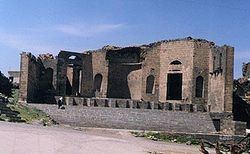Local time Friday 8:05 AM | ||
 | ||
Weather 11°C, Wind W at 5 km/h, 58% Humidity | ||
Shahba (Arabic: شهبا / ALA-LC: Shahbā), known in Late Antiquity as Philippopolis, is a city located 87 km south of Damascus in the Jabal el Druze in As-Suwayda Governorate of Syria, but formerly in the Roman province of Arabia Petraea.
Contents
Map of Shahba, Syria
Roman history
The oasis settlement now named Shahba had been the native hamlet of the Roman emperor Philip the Arab. After Philip became emperor in 244 CE, he dedicated himself to rebuilding the little community as a colonia. The contemporary community that was replaced with the new construction was so insignificant that one author states that the city can be considered to have been built on virgin soil, making it the last of the Roman cities founded in the East.
The city was renamed Philippopolis in dedication to the emperor, who is said to have wanted to turn his native city into a replica of Rome herself. A hexagonal-style temple and an open-air place of worship of local style, called a kalybe, a triumphal arch, baths, a starkly unornamented theatre faced with basalt blocks, a large structure that has been interpreted as a basilica, and the Philippeion (illustration, right) surrounded by a great wall with ceremonial gates, were laid out and built following the grid plan of a typical Roman city.
The public structures formed what author Arthur Segal has called a kind of "imported façade". The rest of the urban architecture was modest and vernacular. The city was never completed as building seems to have stopped abruptly after the death of Philip in 249.
The new city followed the extremely regular Roman grid-plan, with the main colonnaded cardo maximus intersecting a colonnaded decumanus maximus at right angles near the center. Lesser streets marked off insulae, many of which never saw houses constructed upon them.
The city was the seat of a Bishopric; a Christian presence exists in the city to the present.
Ottoman history, and after
In 1596 Shahba appeared in the Ottoman tax registers as Sahba and was part of the nahiya of Bani Miglad in the Qada of Hauran. It had an entirely Muslim population consisting of 8 households and 3 bachelors, who paid taxes on wheat, barley, summer crops, goats and/or beehives.
Because it was far from population centers that would have required cut stone for building and might have quarried it from those deserted in Philippopolis, Shahba today contains well-preserved ruins of the ancient Roman city.
A museum located in the city exhibits some beautiful examples of Roman mosaics. The especially rich iconography of the figurative mosaic on the theme, The Glory of the Earth, discovered in 1952 in the so-called "Maison Aoua", is conserved today in the museum of Damascus and has proved a rich resource for iconographers.
The relatively well-preserved Roman bridge at Nimreh is located in the vicinity.
Modern Era
In the 19th century Druze populations moved into the area. The city has been affected by the Syrian Civil War.
